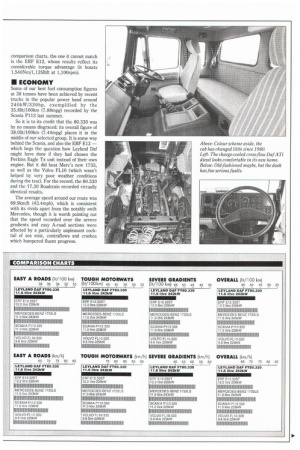• DRIVELINE
Page 38

Page 39

If you've noticed an error in this article please click here to report it so we can fix it.
The arrival of the Series 80 spells the end of proprietary engines in the Leyland Daf tractive unit range, with Cummins and Perkins-powered Roadtrains no longer available. It's also on the cards that the use of these engines in the 80.250 and 80.270 Series 80 Constructor eight-leggers is unlikely to last very long.
Instead the 80 tractor gets two versions of Dal's 11.6-litre diesel, rated at 222kW (298hp) and 242kW (325hp). The more powerful WS242 unit, which we test here, is identical to that used in the latest 95 line-up, and thus benefits from the round of improvements introduced in the 95 last autumn.
These include revisions to the injection system and the combustion chamber, as well as changes to the turbocharger and air-to-air charge-cooler. As a result emissions are said to be comfortably within current standards, while the outputs are competitive with the opposition, although the peak torque of 1,350Nm (9961bft) is developed at an unfashionably high 1,300rpm (maximum power comes in at 2,000rpm).
The Series 80 comes with a choice of transmissions: for fans of the synchromesh box ZF's 16-speed 165-150 is the one to go for, with the constant-mesh alternative being provided by the 12-speed Eaton IS 11612 Twin Splitter. Our truck came with the Eaton box which, with the standard 3.31:1 ratio in Daf's 1346 single-reduction drive axle, gives a geared speed of 1171onfh (73mph), and a theoretical restart gradability of 28% (1-in-3.6).
• PERFORMANCE
The combination of Daf engine and Twin Splitter gearbox may be a new one for UK hauliers, but this should be no cause for concern because the two get along just fine. The installation is a good one, and although the uninitiated may take a while to get into the rhythm of the change, the rewards on offer from swift, clutchless shifting are considerable, particularly when tackling hilly country.
The engine itself is a willing performer, combining decent refinement with a useful working range between 1,200 and 1,700rpm. Though it can lug down below this point, the in-line six doesn't have a particularly low-revving nature, and is at its happiest (and most efficient) around the 1,400rpm mark, corresponding to 80km/h (50mph) in top gear.
Our track tests and hill climbs show the 80.330 to be more than a match for most of its rivals against the stopwatch, as well as being usefully quicker than the old 17.30 Roadtrain.
But of the tractors picked for our comparison charts, the one it cannot match is the ERF E12, whose results reflect its considerable torque advantage (it boasts 1,540Nm/1,135Ibft at 1,100rpm).
• ECONOMY
Some of our best fuel consumption figures at 38 tonnes have been achieved by recent trucks in the popular power band around 240kW/320hp, exemplified by the 35.8lit/100km (7.88mpg) recorded by the Scania P113 last summer.
So it is to its credit that the 80.330 was by no means disgraced: its overall figure of 38.01it/100km (7.44mpg) places it in the middle of our selected group. It is some way behind the Scania, and also the ERF E12 which begs the question how Leyland Daf might have done if they had chosen the Perkins Eagle Tx unit instead of their own engine. But it did beat Merc's new 1733, as well as the Volvo FL10 (which wasn't helped by very poor weather conditions during the test). For the record, the 80.330 and the 17.30 Roadtrain recorded virtually identical results.
The average speed around our route was 69.9km/h (43.4mph), which is consistent with its rivals apart from the notably swift Mercedes, though it is worth pointing out that the speed recorded over the severe gradients and easy A-road sections were affected by a particularly unpleasant cocktail of sea mist, contraflows and crashes which hampered fluent progress.




















































































